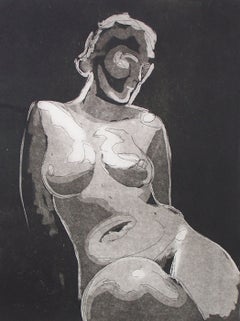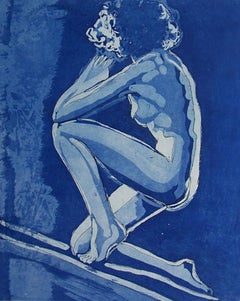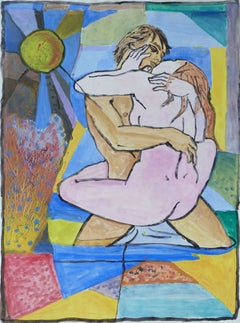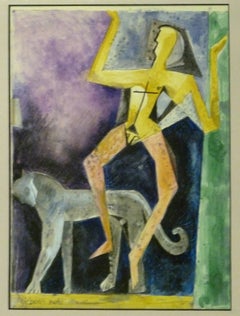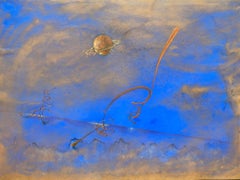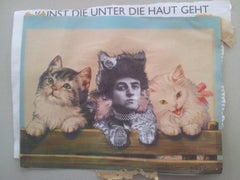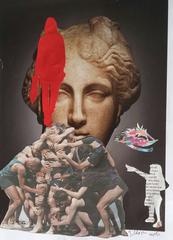Jacob Gildor Art
to
10
8
2
3
1
4
1
1
Overall Height
to
Overall Width
to
4
2
9
5
3
2
2
1
1
1
1
1
1
1
1
1
1
1
1
1
1
3
6
3
10
6,857
3,172
2,516
1,217
4
3
2
2
2
Artist: Jacob Gildor
Nude in Black
By Jacob Gildor
Located in London, GB
This etching is by the artist Jacob Gildor.
This is probably an artist proof aside the standard edition of 20 hand signed and numbered impressions.
Category
Jacob Gildor Art
Moonlight Wolf
By Jacob Gildor
Located in London, GB
JACOB GILDOR b. 1948
(German / Israeli)
Title: Moonlight Wolf, 2015
Technique: Hand Signed Digital Collage Print on Acrylic
Size: 150 x 120 cm. / 59...
Category
2010s Contemporary Jacob Gildor Art
Materials
Digital
Nude II
By Jacob Gildor
Located in London, GB
JACOB GILDOR b. 1948
(German / Israeli)
Title: Nude II, 1996
Technique: Original Hand Signed and Numbered Etching and Aquatint in Colours on Arches Wove Paper
Paper size: 65 x 50...
Category
1990s Contemporary Jacob Gildor Art
Materials
Etching, Aquatint
Nude I
By Jacob Gildor
Located in London, GB
JACOB GILDOR b. 1948
(German / Israeli)
Title: Nude I, 1996
Technique: Original Hand Signed and Numbered Colour Etching and Aquatint on Arches Wove Paper
Paper size: 65 x 50 cm /...
Category
1990s Jacob Gildor Art
Materials
Etching, Aquatint
Couple - Homage to Tremois
By Jacob Gildor
Located in London, GB
JACOB GILDOR b. 1948
(German / Israeli)
Title: Couple - Homage to Tremois, 2003
Technique: Original Hand Signed Gouache and Ink over print
Size: 84 x 59.5 cm / 33 x 23.4 in...
Category
21st Century and Contemporary Jacob Gildor Art
Materials
Gouache
Boy with Panther
By Jacob Gildor
Located in London, GB
JACOB GILDOR b. 1948
(German / Israeli)
Title: Boy with Panther, 2005
Technique: Original Hand Signed and Inscribed Gouache on cardboard
Size: 35 x 27.8 cm / 13.7 x 10.9 in...
Category
21st Century and Contemporary Surrealist Jacob Gildor Art
Materials
Gouache
Target (Esravos/Selves)
By Jacob Gildor
Located in London, GB
JACOB GILDOR b. 1948
(German / Israeli)
Title: Target (Esravos/Selves), 2006
Technique: Original Collage, Ink Paper, Sand on Industrial Cardboard.
Size: 46.2 x 33.2 cm / 18...
Category
21st Century and Contemporary Surrealist Jacob Gildor Art
Materials
Ink
Pocket Nudes
By Jacob Gildor
Located in London, GB
JACOB GILDOR b. 1948
(German / Israeli)
Title: Pocket Nudes, 2007
Technique: Original Hand Signed Collage with Watercolor on cardboard
Size: 25.5 x 30 cm / 10 x 11.8 in
Additional Information: This collage by the Israeli artist Jacob Gildor is hand signed in bleu pen "Gildor" at the lower left of the paper.
It was realised in 2007.
This work is recorded in the artist archive with reference no. 2007-7
Literaute: Jacob Gildor, Segments of Creation: Second Generation, Vol. III, 2009, Israeli Art Museum...
Category
21st Century and Contemporary Surrealist Jacob Gildor Art
Materials
Watercolor
Taurus II
By Jacob Gildor
Located in London, GB
JACOB GILDOR b. 1948
(German / Israeli)
Title: Taurus II, 2003
Technique: Original Hand Signed Tempera and Collage and Ink on cardboard
Size: 25.3 x 35.2 cm / 9.9 x 13.8 in
Additional Information: It is hand signed in black pen "Gildor" at the lower left of the paper.
It was realised in 2003.
This work is recorded in the artist archive with reference no. 2003-12
Exhibited:
1. Forward and Backward, paintings 1966-2003, Sara Kishon Gallery, Tel Aviv, January 2003. No. 6, illustrated pages 10-11.
2. Art Budapst, Antik Enterior, 2006
3. Belvedere Gallery, Budapest , Winter Collection, 2007
Literaute: Jacob Gildor, Segments of Creation, Vol. I, 2009, Israeli Art Museum...
Category
21st Century and Contemporary Surrealist Jacob Gildor Art
Materials
Tempera
The Dance
By Jacob Gildor
Located in London, GB
This colour etching is hand signed in pencil by the artist "Gildor" both in Hebrew and in English at the lower right margin. Additionally, the work is hand inscribed in pen...
Category
1990s Jacob Gildor Art
Related Items
The Abduction of the Sabine Women , a Renaissance drawing by Biagio Pupini
Located in PARIS, FR
This vigorous drawing has long been attributed to Polidoro da Caravaggio: The Abduction of the Sabine Women is one of the scenes that Polidoro depicted between 1525 and 1527 on the façade of the Milesi Palazzo in Rome. However, the proximity to another drawing inspired by this same façade, kept at the Ecole des Beaux-Arts, and to other drawings inspired by Polidoro kept at the Musée du Louvre, leads us to propose an attribution to Biagio Pupini, a Bolognese artist whose life remains barely known, despite the abundant number of drawings attributed to him.
1. Biagio Pupini, a Bolognese artist in the light of the Roman Renaissance
The early life of Biagio Pupini, an important figure of the first half of the Cinquecento in Bologna - Vasari mentions him several times - is still poorly known. Neither his date of birth (probably around 1490-1495) nor his training are known. He is said to have been a pupil of Francesco Francia (1450 - 1517) and his name appears for the first time in 1511 in a contract with the painter Bagnacavallo (c. 1484 - 1542) for the frescoes of a church in Faenza. He then collaborated with Girolamo da Carpi, at San Michele in Bosco and at the villa of Belriguardo.
He must have gone to Rome for the first time with Bagnacavallo between 1511 and 1519. There he discovered the art of Raphael, with whom he might have worked, and that of Polidoro da Caravaggio. This first visit, and those that followed, were the occasion for an intense study of ancient and modern art, as illustrated by his abundant graphic production.
Polidoro da Caravaggio had a particular influence on the technique adopted by Pupini. Executed on coloured paper, his drawings generally combine pen, brown ink and wash with abundant highlights of white gouache, as in the drawing presented here.
2. The Abduction of the Sabine Women
Our drawing is an adaptation of a fresco painted between 1525 and 1527 by Polidoro da Caravaggio on the façade of the Milesi Palace in Rome. These painted façades were very famous from the moment they were painted and inspired many artists during their stay in Rome. These frescoes are now very deteriorated and difficult to see, as the palace is in a rather narrow street.
The episode of the abduction of the Sabine women (which appears in the centre of the photo above) is a historical theme that goes back to the origins of Rome and is recounted both by Titus Livius (Ab Urbe condita I,13), by Ovid (Fasti III, 199-228) and by Plutarch (II, Romulus 14-19). After killing his twin brother Romus, Romulus populates the city of Rome by opening it up to refugees and brigands and finds himself with an excess of men. Because of their reputation, none of the inhabitants of the neighbouring cities want to give them their daughters in marriage. The Romans then decide to invite their Sabine neighbours to a great feast during which they slaughter the Sabines and kidnap their daughters.
The engraving made by Giovanni Battista Gallestruzzi (1618 - 1677) around 1656-1658 gives us a good understanding of the Polidoro fresco, allowing us to see how Biagio Pupini reworked the scene to extract this dynamic group.
With a remarkable economy of means, Biagio Pupini takes over the left-hand side of the fresco and depicts in a very dense space two main groups, each consisting of a Roman and a Sabine, completed by a group of three soldiers in the background (which seems to differ quite significantly from Polidoro's composition).
The balance of the drawing is based on a very strongly structured composition. The drawing is organised around a median vertical axis, which runs along both the elbow of the kidnapped Sabine on the left and the foot of her captor, and the two main diagonals, reinforced by four secondary diagonals. This diamond-shaped structure creates an extremely dynamic space, in which centripetal movements (the legs of the Sabine on the right, the arm of the soldier on the back at the top right) and centrifugal movements (the arm of the kidnapper on the left and the legs of the Sabine he is carrying away, the arm of the Sabine on the right) oppose each other, giving the drawing the appearance of a whirlpool around a central point of support situated slightly to the left of the navel of the kidnapper on the right.
3. Polidoro da Caravaggio, and the decorations of Roman palaces
Polidoro da Caravaggio was a paradoxical artist who entered Raphael's (1483 - 1520) workshop at a very young age, when he oversaw the Lodges in the Vatican. Most of his Roman work, which was the peak of his career, has disappeared, as he specialised in facade painting, and yet these paintings, which are eminently visible in urban spaces, have influenced generations of artists who copied them abundantly during their visits to Rome.
Polidoro Caldara was born in Caravaggio around 1495-1500 (the birthplace of Michelangelo Merisi, known as Caravaggio, who was born there in 1571), some forty kilometres east of Milan. According to Vasari, he arrived as a mason on the Vatican's construction site and joined Raphael's workshop around 1517 (at the age of eighteen according to Vasari). This integration would have allowed Polidoro to work not only on the frescoes of the Lodges, but also on some of the frescoes of the Chambers, as well as on the flat of Cardinal Bibiena in the Vatican.
After Raphael's death in 1520, Polidoro worked first with Perin del Vaga before joining forces with Maturino of Florence (1490 - 1528), whom he had also known in Raphael's workshop. Together they specialised in the painting of palace façades. They were to produce some forty façades decorated with grisaille paintings imitating antique bas-reliefs.
The Sack of Rome in 1527, during which his friend Maturino was killed, led Polidoro to flee first to Naples (where he had already stayed in 1523), then to Messina. It was while he was preparing his return to the peninsula that he was murdered by one of his assistants, Tonno Calabrese, in 1543.
In his Vite, Vasari celebrated Polidoro as the greatest façade decorator of his time, noting that "there is no flat, palace, garden or villa in Rome that does not contain a work by Polidoro". Polidoro's facade decorations, most of which have disappeared as they were displayed in the open air, constitute the most important lost chapter of Roman art of the Cinquecento. The few surviving drawings of the painter can, however, give an idea of the original appearance of his murals and show that he was an artist of remarkable and highly original genius.
4. The façade of the Milesi Palace
Giovanni Antonio Milesi, who commissioned this palace, located not far from the Tiber, north of Piazza Navona, was a native of the Bergamo area, like Polidoro, with whom he maintained close friendly ties. Executed in the last years before the Sack of Rome, around 1526-1527, the decoration of Palazzo Milesi is considered Polidoro's greatest decorative success.
An engraving by Ernesto Maccari made at the end of the nineteenth century allows us to understand the general balance of this façade, which was still well preserved at the time. The frescoes were not entirely monochrome, but alternated elements in chiaroscuro simulating marble bas-reliefs and those in ochre simulating bronze and gold vases...
Category
16th Century Old Masters Jacob Gildor Art
Materials
Ink, Gouache, Pen
Paysage linéaire by José Gerson - Gouache on paper 69x50 cm
Located in Geneva, CH
Work on paper without frame
Category
1980s Surrealist Jacob Gildor Art
Materials
Pastel, Gouache, Carbon Pencil
H 27.17 in W 19.69 in D 0.4 in
Ukrainian Dream
Located in Palm Springs, CA
Vitaly was considered an up and coming artist in his native Ukraine, after years of training under one of the Ukraine’s greatest graphic artists...
Category
Early 2000s Contemporary Jacob Gildor Art
Materials
Etching, Aquatint
Surrealist Gouache Watercolour on Paper.
Located in Cotignac, FR
Late 20th century gouache and watercolour on paper by British artist Derek Carruthers. The painting is signed to the bottom right and signed and dated 1985 to the reverse.
An impos...
Category
Late 20th Century Surrealist Jacob Gildor Art
Materials
Paper, Watercolor, Gouache
Untitled (Surrealist rendering of Pyramids at Giza with alligator)
By Beni E. Kosh
Located in Fairlawn, OH
Untitled (Surrealist rendering of Pyramids at Giza with alligator)
watecolor and gouache on paper, 1960
Unsigned
Beni Kosh estate stamp No. 717 verso, unsigned.
(see photo)
Co...
Category
1960s Surrealist Jacob Gildor Art
Materials
Gouache, Watercolor
Against Green
By Arthur B. Davies
Located in New York, NY
Arthur B. Davies (1862-1928), Against Green (also Three Figure Composition, Figures Against Green), soft ground etching and aquatint, 1918, signed in pencil lower right; also titled ...
Category
1910s American Impressionist Jacob Gildor Art
Materials
Etching, Aquatint
Playing With Fire
By Art Werger
Located in Palm Springs, CA
Medium: Etching and Aquatint
Year: 2024
Edition: 25
Image Size: 12 x 18 inches
Signed, titled and numbered in pencil by the artist
Dramatic etching of a male nude juggler performing a fire breathing act. From the artist's Circus cycle of prints.
Werger has received over 250 awards in national and international exhibitions. In 2015 he recieved the Guanlan International Printmaking Prize at the Guanlan Biennial in China, followed by the Grand Prize at the Ekaterinburg mezzotint festival in Russia. In 2012 he received the Award of the Rector at the International Print Triennial in Krakow, Poland and the Prize for Full Correspondence between technique and Imagery at the First International Mezzotint Festival in Ekaterinburg, Russia. He currently teaches printmaking at Ohio University, in Athens Ohio. Previously he served at the Chairman of the fine Arts division, and as professor of Art, at Wesleyan College in Macon...
Category
2010s Contemporary Jacob Gildor Art
Materials
Aquatint, Etching
20th Century Surrealist Painting By Harold Hitchcock
By Harold Hitchcock
Located in Hoddesdon, GB
Harold Hitchcock 1914-2009
A breathtakingly beautiful watercolour painting by one of the 20th century’s most admired English artists .
This is a rare early work by the artist dated 1...
Category
1950s Surrealist Jacob Gildor Art
Materials
Watercolor
H 18.51 in W 20.48 in D 0.99 in
'Reclining Nude', Perugia, USC, Norton Simon, AIC, LACMA, Whitney, Smithsonian
By Ruth Weisberg
Located in Santa Cruz, CA
Polychrome etching and sugar-lift aquatint.
Signed lower right, 'Ruth Weisberg' (American, born 1942) and dated 1967; additionally titled, lower center, 'Joseph Dreamed a Dream' and...
Category
1960s Post-Impressionist Jacob Gildor Art
Materials
Aquatint, Paper, Etching
By the Sea (aka Idyll)
By Arthur B. Davies
Located in New York, NY
Arthur B. Davies (1862-1928), By the Sea (aka Idyll), soft ground etching and aquatint, 1919, signed in pencil lower right. Reference: Czestochowski 72, fourth state (of 5; see disc...
Category
1910s American Impressionist Jacob Gildor Art
Materials
Etching, Aquatint
“New Place” Limited Print - Edition of 58 by Frank Arnold
By Frank Arnold
Located in Fresno, CA
Frank Arnold is thought by many to be one of the foremost abstract figurative painters and sculptors of our time. He is a living master whose work is considered to be both personal a...
Category
2010s Abstract Jacob Gildor Art
Materials
Archival Ink, Archival Paper, Archival Pigment
'The Female Gaze', NYMoMA, California College of Arts and Crafts, SFAI, CPLH
By Gerald Gooch
Located in Santa Cruz, CA
Signed lower center, 'Gooch', for Gerald Gooch (American, born 1933) with number and limitation, '5/16' and dated 1965.
Born in Mainington, West Virginia, Gerald Gooch first studied...
Category
1960s Modern Jacob Gildor Art
Materials
Etching, Paper, Aquatint
Previously Available Items
Cats: Kunst die Unter
By Jacob Gildor
Located in New York, NY
Collage on paper
Category
21st Century and Contemporary Contemporary Jacob Gildor Art
Materials
Magazine Paper
The queen is naked
By Jacob Gildor
Located in New York, NY
Collage on paper.
Category
2010s Contemporary Jacob Gildor Art
Materials
Magazine Paper
Nude II
By Jacob Gildor
Located in London, GB
JACOB GILDOR b. 1948
(German / Israeli)
Title: Nude II, 1996
Technique: Original Hand Signed and Numbered Colour Etching on Arches vellum paper
Paper size: 65 x 50 cm / 25...
Category
1990s Jacob Gildor Art
Materials
Etching
Black and white
By Jacob Gildor
Located in New York, NY
Ink and collage on paper.
Signed ,signed again and dated verso.
Category
Contemporary Jacob Gildor Art
Materials
Ink
Seated Woman in Green
By Jacob Gildor
Located in London, GB
JACOB GILDOR b. 1948
(German / Israeli)
Title: Seated Woman, 2010
Technique: Original Hand Signed and Numbered Colour Etching and Aquatint on Arches vellum paper
Paper Size...
Category
21st Century and Contemporary Jacob Gildor Art
Nude II
By Jacob Gildor
Located in London, GB
JACOB GILDOR b. 1948
(German / Israeli)
Title: Nude II, 1996
Technique: Original Hand Signed and Numbered Colour Etching on Arches vellum paper
Paper Size: 65 x 50 cm / 25...
Category
1990s Jacob Gildor Art
Materials
Etching
Jacob Gildor art for sale on 1stDibs.
Find a wide variety of authentic Jacob Gildor art available for sale on 1stDibs. If you’re browsing the collection of art to introduce a pop of color in a neutral corner of your living room or bedroom, you can find work that includes elements of blue and other colors. You can also browse by medium to find art by Jacob Gildor in paint, watercolor, aquatint and more. Much of the original work by this artist or collective was created during the 21st century and contemporary and is mostly associated with the Surrealist style. Not every interior allows for large Jacob Gildor art, so small editions measuring 11 inches across are available. Customers who are interested in this artist might also find the work of Howard Kanovitz, Alexander Brodsky and Ilya Utkin, and Sage Barnes. Jacob Gildor art prices can differ depending upon medium, time period and other attributes. On 1stDibs, the price for these items starts at $1,600 and tops out at $3,000, while the average work can sell for $2,400.
